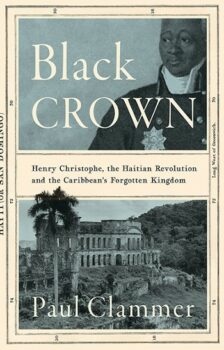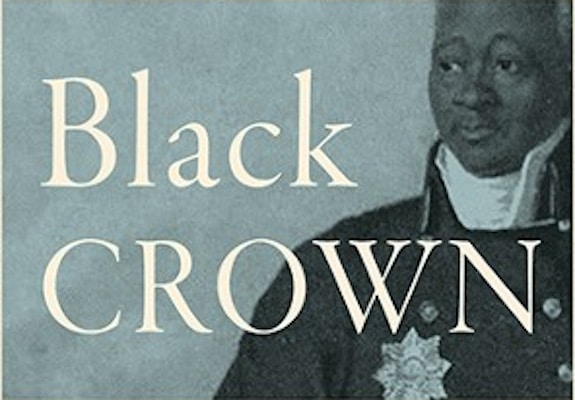Paul Clammer’s Black Crown is a great historical narrative that introduces the reader to an array of fascinating characters in an age of revolution. Black Crownis a biography of Henri Christophe, who began life as a slave on the island of Grenada and died as the King of Haiti, and whose life spanned the War of American Independence, the French Revolution and Napoleon’s dictatorship in France, as well as the Haitian Revolution, in which he played a leading role.

Paul Clammer, Black Crown: Henri Christophe, the Haitian Revolution and the Caribbean’s Forgotten Kingdom (Hurst & Company, 2023) pp 378.
The Haitian Revolution was made by slaves who rose up and destroyed the apparatus of their enslavement, and then proceeded to declare their independence from the European slave empires. Christophe fought in the revolutionary army alongside figures such as Toussaint Louverture and Jean Jacques Dessalines, and his biography adds much to the scholarship of the period.
The slave years
Paul Clammer is not an academic historian and is better known for writing travel guides. He decided to research and write this book after visiting Haiti and seeing Christophe’s legacy. Black Crown is, nevertheless, a very good history, and Clammer should be commended for his painstaking research. Christophe’s early life was spent in slavery and went unrecorded. Clammer set himself the task of reading the biographical accounts of Christophe’s slave years that were mostly composed after his death. From these Clammer has pieced together a picture of Christophe’s life and the events that made this remarkable man.
Christophe was to become Toussaint Louverture’s second-in-command during the years of Haiti’s revolution, and he began his life as a soldier during the American War of Independence. Christophe was born into slavery in Grenada and he was dragooned into the French army to fight the British in the American colonies. Joining the army was accompanied by the promise of freedom, and also gave Christophe a new set of skills including a penchant for military discipline. He served in the battle for Savannah, probably as a drummer, and saw black soldiers killing white soldiers, which as a twelve-year-old boy, had a profound effect on him.
The French army was disbanded in Haiti, which was then called St Domingue, and Christophe began a new life of service there. He worked at a popular inn in Cap Français, now Cap Haitien. (At this point it is worth saying that the book would benefit from some maps and a timeline, to help readers unfamiliar with the topic.)
Cap Français served the northern plain of sugar plantations. Christophe, whose political sympathies always aligned with the urban classes, saw the workings of the plantation economy first hand. He saw the vast trade in sugar and slaves that took place in the city. Two thirds of the world’s sugar was processed in St Domingue. The plantations themselves took a huge toll on human lives. Some 18,000 slaves a year were sold at the slave market near the harbour.
Christophe also gained an insight into the political impulses coming into Cap from Europe. As the revolution in France began, the white French population in St Domingue divided into Royalists and Republicans. It is a complex history of ever-changing forces and outcomes that the author handles well.
The war against France, 1791-1804
The Haitian Revolution was ignited by revolution in France. Liberty, Equality and Fraternity were seized upon by slaves in the French colonies. In 1791, in a founding ceremony of the revolution, the chief conspirator, a coachman called Boukman, gave the oath through which the slaves would get their freedom. Boukman invoked a mixture of vodou and Christian sentiments that declared unequivocal war on the whites (p.48).
The ‘equality’ of the enslaved meant killing their oppressors. It terrified European and American slave owners. The slaves fought a brilliant campaign of guerrilla warfare that also generated outstanding military leaders.
Christophe found his way into the military when he was enrolled in the city militia in Cap Français. The city was beset by disputes between Republican commissioners that supported revolution and white racists who had access to weapons and their own militia. In 1793, Christophe and the defenders burnt the city rather than surrender to the racists. Christophe joined the revolutionary army and quickly rose through the ranks. His great skill was as an organiser rather than a battle commander, although when called upon he proved himself to be courageous and determined.
Provisioning an army is a huge task, and Christophe excelled at it. His troops were noted for being well-rationed, well-uniformed and well-drilled. As a British officer, used to seeing battles fought in the European manner of squared formations, observed:
At a whistle a whole brigade ran three or four hundred yards, threw themselves flat on the ground, changing to their backs or sides, keeping up a strong fire the whole of the time, till they were recalled; they then formed again, in an instant, into their former regularity (p.65).
Toussaint Louverture was the revolution’s leading figure, and there is more to say about him than a biography of Christophe allows. Nevertheless, Paul Clammer establishes the continuity between Louverture and Christophe very well.
The problem for the leaders of the revolution was always going to be the issue of independence. Independence required defence, and defence required money. Without defence, St Domingue would always have to ally with one or other of the European slave empires, and that would mean the danger of being cast back into slavery. Louverture, and Christophe after him, could only see the costs of maintaining a national army capable of upholding independence coming from plantation agriculture. This was to sow divisions between the freed slaves. However, Louverture would not be the one to address the issue.
In 1802, Napoleon sent an armada to take back St Domingue and re-impose slavery. Toussaint had now been declared governor for life, and with the right to appoint his heir. He was enraged that Napoleon could tear up the ideals of liberty and send the country back to slavery.
The invasion was led by Napoleon’s brother-in-law, Leclerc. It was to be a disaster. Once again, Cap Français was burnt and the victorious French army captured a pile of ashes. Then followed a brutal guerrilla war. French soldiers fell in droves to the predation of yellow fever and battle-hardened freed slaves. When Leclerc himself succumbed, the war with France was all but over. At the Battle of Vertières, the French surrendered, and in 1804 Jean Jacques Dessalines (Louverture had been tricked into going to France, where he died in prison) declared Haitian independence (p.123).
The price of freedom
Haitian independence had a huge impact on world history. The defeat of France in the Caribbean would see Napoleon intensify the war in Europe. Maintaining a French empire in the Caribbean was increasingly difficult, and when France sold its possessions in North America – the Louisiana Purchase – the balance of power in the world shifted visibly.
Haitian independence also had an impact on the future of slavery itself. It acted as an exemplar of how to gain freedom for other slave colonies, and this would in turn demand more military policing of the Caribbean. In 1807 Britain abolished the slave trade, in part because of the impact of the Haitian Revolution on the slave system generally.
Furthermore, abolitionists in Britain became intrigued by the trajectory of Haitian politics after independence. Two features stand out. Firstly, the constitution of Haiti explicitly forbade slavery. This was the first constitution in the world to do this, and was therefore far more radical than the US Bill of Rights and the French Declaration of the Rights of Man and Citizen.
Secondly, the governments after 1804 legislated that plantation agriculture must be preserved as a national duty to provide the funds for a national government and standing army. Free labour would in essence, be forced to work for wages. This was music to the ears of abolitionists in Britain, who wanted to show that ending slavery would not mean the abolition of profits from slave-produced goods.
Dessalines, as Toussaint Louverture’s heir, had been the first to insist that maintaining Haiti’s export crops would be the key to remaining ‘free’. But the anger of freed slaves at being told how to live their lives was always going to surface. Dessalines was soon to be ambushed and murdered after a visit to Port-au-Prince in the south, where the labour codes were most strongly resisted (p.151).
King Henri Christophe
After Dessalines was murdered, the generals turned to Christophe as their saviour. Christophe was not just an officer. He was considered to be a person capable of building the nation. Whereas Dessalines had held the title of Governor General, the officer elite suggested that Christophe might enjoy the more democratic title of President. Christophe declined the offer, and the decision takes some explanation.
Socialist readers might be perplexed that Christophe chose kingship in preference to democracy, but Haiti had fought a war for independence against the most radical regime in Europe. Although the revolutionaries had initially banned slavery, Napoleon had reinstated it. Military force rather than democracy had taken Haiti to this point and the landed elite that the revolution overthrew was French and white.
It should also be noted that Africans were familiar with monarchical rule and as the book illustrates, African influences in art, architecture and education were strongly represented. But although monarchy had roots in Africa, what Christophe and his advisers produced, in a conscious attempt to secure British goodwill, was dictatorial.
The constitutional arrangements for the new monarchy were formalised in the Code Henri that set out human rights and obligations in what admirers in Britain thought of as a benevolent dictatorship. It is true that in terms of the more just penal code and provision for education and welfare, Haiti went far beyond what workers had in Britain, but the system of forced agricultural labour locked the former slaves into the merciless plantation system.
Black Crown gives a lot of detail on the trappings of Haitian monarchy. Christophe built himself a vast palace at Sans Souci, as well as the most impressive hilltop fortress in the Americas. Courtly dress, carriages, works of art and the adoption of Catholicism as the state religion may have impressed British onlookers, but it created huge resentment too.
Christophe survived by turning the country into a militarised state, yet the lack of intermediate social layers between the labourers and the monarchy left him vulnerable. In 1804, during mass, Christophe had a stroke. It was a very public calamity, witnessed by his generals. Forced to retreat to the inner sanctum of his palace for recovery, plots against him soon arose. His generals were already conspiring when an invasion from the south, where a separate republican regime had taken shape after Dessalines’ assassination, approached too. Christophe’s famed decisiveness had gone. As his enemies moved ever closer, he committed suicide, and monarchy was never to return.
Summary
Black Crown is a very readable book, and I would recommend it. Readers will gain an insight into the complexities of the Haitian Revolution and the many intractable problems that it threw up. But above all the book is a gripping read. As historical biographies go, Paul Clammer has produced one that is authoritative and well researched, and it takes us into a period of history about which we need to know more.

